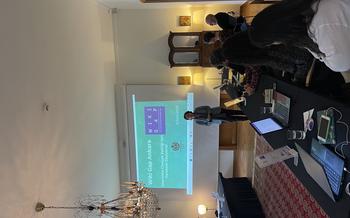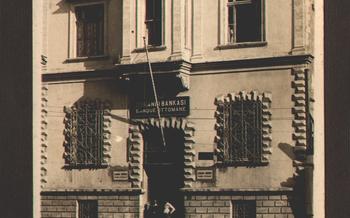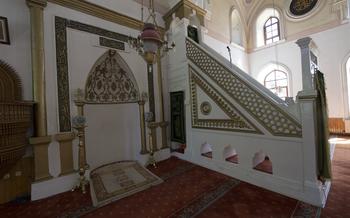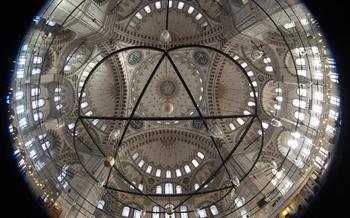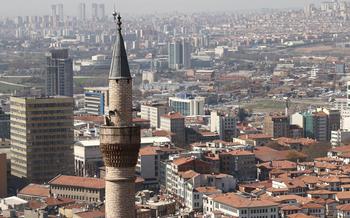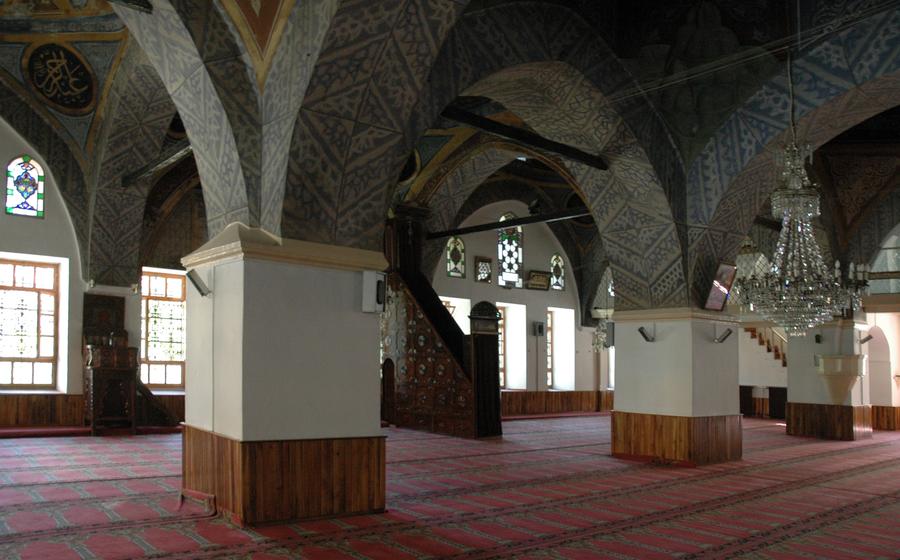
Kastamonu Ulu Mosque
- The Antiquity of Kastamonu Ulu Mosque
- Exploring the Mosque's Exterior
- Stepping Inside the Mosque
- The Story of the Mosque's Construction
- Visiting the Mosque's Museum
- Attending Prayer Services
- Discovering the Legends and Folklore
- The Mosque's Role in Local Life
- The Mosque's Impact on Kastamonu's History
- The Best Time to Visit
- Transportation and Parking
- Nearby Attractions and Activities
- Insider Tip: Unraveling the Hidden Treasure of Kastamonu Ulu Mosque
The Antiquity of Kastamonu Ulu Mosque
Kastamonu Ulu Mosque stands as a testament to the rich history and architectural heritage of Kastamonu, Turkey. Built in the 15th century during the reign of Ottoman Sultan Murad II, the mosque holds a significant place in the city's cultural and religious landscape. Its construction epitomizes the blending of Islamic architectural traditions with local Anatolian influences, resulting in a unique and awe-inspiring structure. The mosque's location in the heart of Kastamonu further enhances its significance, making it a focal point for both locals and visitors.
Exploring the Mosque's Exterior
The exterior of the Kastamonu Ulu Mosque is a testament to the grandeur and artistry of Ottoman architecture. As you approach the mosque, your gaze is drawn to the imposing entrance, flanked by two tall minarets. The grand courtyard, with its serene ambiance, invites you to pause and admire the intricate stone carvings and decorations that adorn the mosque's facade. The impressive dome, a symbol of Islamic architecture, dominates the skyline, adding to the mosque's majestic presence. The minarets, with their intricate balconies and tapering spires, stand as proud sentinels, calling the faithful to prayer.
Stepping Inside the Mosque
Passing through the grand entrance of Kastamonu Ulu Mosque, visitors are greeted by a spacious and awe-inspiring prayer hall. The vast interior is adorned with intricate carvings, colorful tiles, and elegant calligraphy, creating a harmonious blend of art and spirituality. The layout of the hall is designed to facilitate communal worship, with rows of prayer mats neatly arranged facing the mihrab (prayer niche). The mihrab itself is a masterpiece of craftsmanship, featuring intricate geometric patterns and Quranic verses. The minbar (pulpit) stands beside the mihrab, its elegant design adding to the overall grandeur of the mosque. The walls and ceiling are adorned with beautiful calligraphy and inscriptions, showcasing verses from the Quran and Islamic teachings. These inscriptions not only add to the aesthetic beauty of the mosque but also serve as reminders of the spiritual significance of the space.
The Story of the Mosque's Construction
The construction of the Kastamonu Ulu Mosque was a testament to the dedication and skill of the Ottoman Empire's finest architects and craftsmen. The project was commissioned by Sultan Bayezid II, who ruled the empire from 1481 to 15He entrusted the task to the renowned architect Mimar Sinan, who was responsible for designing many of the empire's most iconic structures.
Mimar Sinan faced several challenges during the construction. The mosque was built on a sloping site, which required careful engineering to ensure stability. Additionally, the region was prone to earthquakes, so the mosque had to be designed to withstand seismic activity.
Despite these challenges, the mosque was completed in 1487 after four years of construction. It stands as a testament to the architectural prowess of the Ottoman Empire and the skill of its craftsmen.
Visiting the Mosque's Museum
The Kastamonu Ulu Mosque boasts a small but fascinating museum that sheds light on its rich history and cultural significance. Inside, visitors can delve into the mosque's past through a collection of well-preserved artifacts, historical documents, and captivating exhibits. These relics provide a glimpse into the mosque's construction, its role in the community, and its place in the broader Islamic world.
The museum's displays showcase intricate manuscripts, religious texts, and decorative objects that once adorned the mosque. Visitors can admire the exquisite calligraphy that graces the pages of these ancient manuscripts, each letter meticulously penned by skilled scribes. Historical documents, such as foundation deeds and architectural plans, offer insights into the mosque's early days and its evolution over the centuries.
Beyond these tangible artifacts, the museum also presents interactive exhibits that bring the mosque's story to life. Through multimedia presentations and virtual reality experiences, visitors can virtually step back in time and witness the mosque's construction, marvel at its architectural grandeur, and immerse themselves in the vibrant atmosphere of prayer services.
A visit to the Kastamonu Ulu Mosque Museum is a must for anyone seeking a deeper understanding of the mosque's significance. It provides a unique opportunity to learn about Islamic art and architecture, explore the mosque's historical and cultural context, and gain a greater appreciation for this architectural masterpiece.
Attending Prayer Services
Witness the spiritual essence of the Kastamonu Ulu Mosque by attending one of its prayer services. Immerse yourself in the tranquil atmosphere as the faithful gather, filling the mosque with their heartfelt recitations and prostrations. Observe the imam leading the prayers with his melodic voice, guiding the congregation in their devotion. Experience the unity and harmony as the community bows and rises together, their hearts aligned in worship. It's an opportunity to connect with the local Muslim community, share in their sacred rituals, and gain a deeper understanding of Islamic traditions.
Discovering the Legends and Folklore
The Kastamonu Ulu Mosque is not only a remarkable architectural marvel but also a source of numerous legends and folklore that have been passed down through generations. Locals recount fascinating tales associated with the mosque's construction and miraculous events. One legend narrates that the mosque was built in a single night by a group of angels who descended from the heavens. Another story speaks of a pious man who prayed fervently for the construction of a grand mosque in Kastamonu, and his prayers were answered when the mosque miraculously appeared overnight. These captivating narratives add to the mosque's mystique and provide a glimpse into the cultural significance it holds within the community.
The Mosque's Role in Local Life
Kastamonu Ulu Mosque serves as a vital hub for religious and community gatherings in the city. It fosters a sense of unity among the local Muslim population, providing a sacred space for prayer, contemplation, and spiritual connection. Beyond its religious significance, the mosque also plays a crucial role in education and social welfare activities, contributing to the overall well-being of the community. It hosts religious classes, workshops, and seminars, promoting Islamic teachings and fostering a deeper understanding of the faith. Additionally, the mosque actively engages in charitable initiatives, offering support to those in need and promoting social justice and harmony. Through its multifaceted role, Kastamonu Ulu Mosque stands as a symbol of unity and cultural identity, embodying the values of compassion, inclusivity, and community spirit that are deeply ingrained in the fabric of Kastamonu society.
The Mosque's Impact on Kastamonu's History
The Kastamonu Ulu Mosque stands as a testament to the city's rich past, playing a pivotal role in shaping Kastamonu's cultural heritage. The mosque's architectural grandeur reflects the city's status as an important center of Islamic art and architecture during the Ottoman period. Its intricate stone carvings, elegant calligraphy, and impressive dome have become iconic symbols of Kastamonu's cultural identity.
The mosque's construction during the reign of the Ottoman Sultan Bayezid II marked a significant milestone in Kastamonu's history. The mosque's presence transformed the city into a prominent religious and cultural center, attracting scholars, artists, and pilgrims from across the region. The mosque's establishment fostered a vibrant intellectual and artistic environment, contributing to the city's overall development and prosperity.
Kastamonu Ulu Mosque's enduring legacy lies in its ability to transcend religious boundaries and serve as a symbol of unity and cultural identity for the people of Kastamonu. The mosque's architectural beauty and historical significance have made it a beloved landmark, attracting both local residents and visitors alike. It remains a source of pride for the city, reminding its inhabitants of their rich cultural heritage and the mosque's enduring impact on Kastamonu's identity.
The Best Time to Visit
The best time to visit the Kastamonu Ulu Mosque is during the shoulder seasons, which fall between April and May, and September and October. During these times, the weather is generally mild and pleasant, with fewer crowds compared to the peak summer season. This allows for a more relaxed and unhurried exploration of the mosque and its surroundings.
As for the time of day, early mornings or late afternoons offer the most favorable lighting conditions for photography enthusiasts. The warm, golden hues of the rising or setting sun beautifully illuminate the mosque's intricate carvings and architectural details, creating stunning photo opportunities.
Transportation and Parking
The Kastamonu Ulu Mosque is easily accessible by foot or public transportation, as it is situated in the heart of the city center. For those arriving by car, there are several designated parking areas within walking distance. One option is the parking lot behind the mosque, which offers a convenient and secure space for vehicles. Additionally, the surrounding area features several on-street parking spaces, providing ample options for visitors. To facilitate your journey, consider using a navigation app or asking locals for directions, ensuring a smooth and stress-free arrival.
Nearby Attractions and Activities
While visiting the Kastamonu Ulu Mosque, take advantage of the opportunity to explore the other historical and cultural treasures that Kastamonu has to offer. The city is home to several other landmarks, museums, and sites that provide a deeper insight into its rich past and vibrant culture.
Wander through the narrow streets of the old city and discover hidden gems like the Kastamonu Castle, a symbol of the city's resilience that offers stunning panoramic views. Visit the Kastamonu Museum to delve into the region's history and admire artifacts from various eras. Explore the traditional Turkish houses and shops in the bazaar, where you can find unique souvenirs and local delicacies.
Indulge in the flavors of Turkish cuisine at one of the many restaurants in Kastamonu. Savor the taste of traditional dishes like "mantı," small dumplings served with yogurt and tomato sauce, or "kastamonu kebabı," grilled lamb served with rice and vegetables.
For nature enthusiasts, the Ilgaz Mountain National Park, located just outside the city, offers breathtaking landscapes, hiking trails, and camping opportunities. Immerse yourself in the beauty of the natural surroundings and enjoy the fresh mountain air.
With its rich history, cultural heritage, and stunning natural landscapes, Kastamonu is a destination that offers a truly immersive and memorable experience for every traveler.
Insider Tip: Unraveling the Hidden Treasure of Kastamonu Ulu Mosque
In the heart of Kastamonu Ulu Mosque, there lies a hidden gem that few visitors know about—a secret chamber tucked away behind a discreet door. This chamber houses a collection of ancient manuscripts and texts, some dating back centuries. Among these treasures is a rare and beautifully illuminated Qur'an, believed to have been written during the mosque's early days. For history buffs and those seeking a deeper connection to the mosque's past, this hidden chamber offers a glimpse into the rich cultural and religious heritage of Kastamonu.




